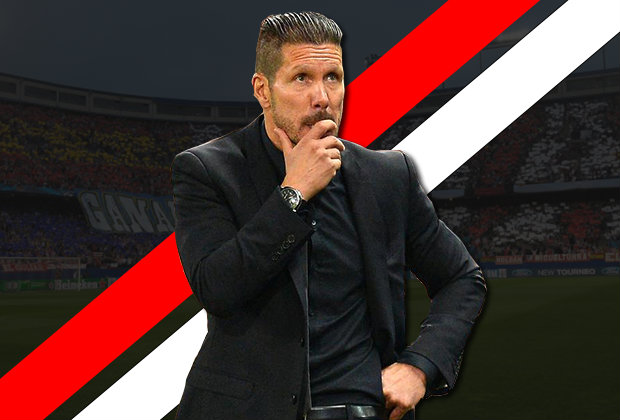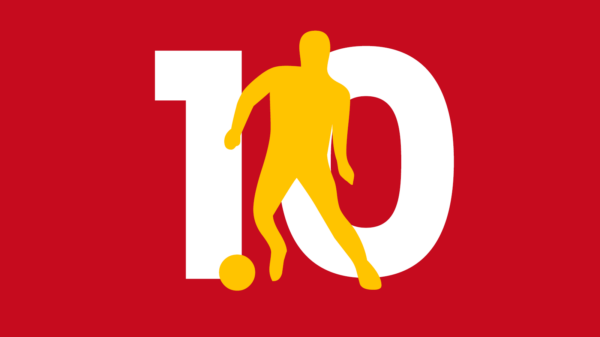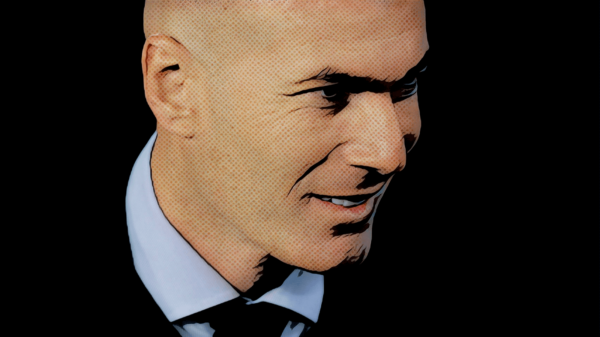Diego Simeone is out there to prove that last season’s wonders with Atletico Madrid were not fluke. With big names leaving and a few arriving at the Madrid club, the former Atletico captain has looked to bring a few tactical changes and impose a title challenge. Constantin Eckner takes a look at headway Simeone has made this season.
Diego Simeone is not out to eat humble pie. The 44-year-old Argentinian is hell bent on retaining the league title and going one step better than last season in the Champions League. Without having Real Madrid’s and Barcelona’s payrolls, Atlético have gained success with a combination of sly tactics, strong leadership from a go-getting persona like Simeone, and a matchless spirit. And the Rojiblancos, long known as the “other team” in the Spanish capital, are a title contender in La Liga again.
Looking Back
Having conceded a Sergio Ramos last-minute equalizer and three more goals in over-time, Atlético lost the Champions League final to city rival Real Madrid in dramatic fashion. But, moreover, Rojiblancos coach Diego Simeone was asked to rebuild the squad throughout the summer transfer window. Key players such as Diego Costa and Filipe Luís have signed for Chelsea, Thibaut Courtois has gone back to his parent club, the experienced David Villa has moved to Melbourne and Adrián López has taken his chance at Porto.
In recent seasons, Atlético have been one of the few teams that have used a 4-4-2 formation on both offense and defence. And, in contrast to the traditional English version of the 4-4-2, Simeone has made necessary adjustments. The Argentinian has focused on strategically important centre spaces, while a traditional 4-4-2 usually lacks coverage of the space between both forwards and both holding midfielders. However, the Colchoneros have kept with the tradition of abandoning that space, but have usually played a 4-2-2-2 with two narrow wingers and aligned their position with the half spaces. Consequently, both wingers have opened the wings for the wide-range movement of both full-backs, with a centre forward dropping deep, or occasionally moving up a centre midfielder to fill the in the middle. Moreover, Atlético have created sometimes a narrowness to provide quick combination plays with attempts to break through.
Having used Koke and Arda Turan as inverted wingers, Atlético have had the option to play shorter passes from one side to the other, and, therefore, that has confused man-orientated defending teams, as both wingers have behaved occasionally like no. 10s. Moreover, Koke and Turan have shown their dribbling skills to make breakthroughs. Most notably, the Turk is great in isolated situations.
Simeone’s side have shown a pattern within their transition plays. Having won the ball on the left side, Filipe Luís, Koke and Diego Costa played 1-2s through the half-space, and, afterwards, the ball came to Turan on the right side, as he was freed by the previous movement. In addition, David Villa or Adrián as second striker has also repeatedly moved to the wing when near the ball to receive long passes or act as a space opener for the winger. Furthermore, Turan, Koke and Raúl García have positioned themselves intelligently for through balls in the space between the lines in many occasions. When an opposing team was reacting with a consistent man-marking of the attacking wingers, the lateral zones were open to the full-backs.
New Signings
Mario Mandžukić has primarily a physically strong stature, and offers an uncompromising way of playing in the centre. Despite acceptable technical qualities, his start has not run smoothly. The Croatian seems to have been a foreigner within the system. On the one hand, he has not been able to contribute to the pressing, and acted less intensively. On the other hand, the other attacking players have obviously looked for Diego Costa, but found Mandžukić. He has often received the ball in the second third, but could not pass the ball back, as he has struggled in those closely defended situations, and lost the ball in many occasion. This kind of offensive style of play has been inappropriate for the 22-million-euro signing, but, in the meantime, Atlético have widely changed. By now, Simeone’s side act more goal-orientated and play the ball more directly into the penalty area.
Antoine Griezmann needed a short period of familiarization too. In addition, his variability is blessing and a curse, as he has been used in different roles throughout the season. However, the 23-year-old has often taken the wrong decision, and has gotten tangled up in risky dribbling too often. Griezmann has had to adapt and he could see in the first few months that Simeone is not a coach who blindly fields a player just because he has cost a huge sum. Griezmann has refused lucrative offers from other clubs after his value had increased at the World Cup in Brazil again. After all, the French has become a valuable part of the team, and he has scored many important goals lately.
The loss of Filipe Luís seems to have been underestimated in public, but is a significant one as the player has been a key figure. Juanfran is a very long-range line runner at right-back, whereas Filipe has been the deep, play-making factor in Atlético’s offensive structure, which has been left-orientated due to Diego Costa’s moves to the side and Koke’s ability to create effective combinations in small pockets. To compensate the loss of Filipe, the Rojiblancos bought Guilherme Siqueira from Granada who has recently played for Benfica. The 28-year-old is a mixture of an advancing, more dominant winger and a combination-orientated full-back. Putting the creative aspect aside, Siqueira should probably resemble the outstanding Filipe. Moreover, because Emiliano Insua has been loaned to Rayo, Cristian Ansaldi has gone on loan from Zenit to Atleti. He is rather assessed as an equivalent to Juanfran, and offers a linear movement with a thing for crosses. Both new left-backs have already been called into action, both worked in their own way, but each has plenty of upside potential. The experienced Jesús Gámez fills the second right-back position. In midfield, Saúl Ñíguez has returned to his parent club after his loan spell at Rayo Vallecano. Simeone has a high opinion of the talented 21-year-old, and already compares him with the likes of Koke and Gabi. Actually, Saúl is not only used as a holding midfielder, but has played also on the left wing or as a left-centre midfielder, so he provides even more variability in Atlético’s midfield.
Seek Security in the Tried and Tested
On the one hand, it has been apparent that Simeone wanted to preserve the system of last season, and still trusted the 4-4-2 or 4-4-1-1. But, on the other side, it has been only played in an attempted like manner. In practice, this means that the typical compactness in midfield has not been given; sometimes the wingers have stood in front of the full-back. That is something what was unthinkable last season. Showing a lack of horizontal compactness, Atlético have not been able to control the opposing build-up play, and to lure them into pressing traps. Overall, the two lines of four have not been more than passive blockades, while the front line stood too high, and so has usually been out-played due to the hole behind the two strikers. In addition, the centre midfield has not functioned like a pendulum what we used to see last season, as one of the holding players has usually dropped deeper, while he stood on the far side, and pushed diagonally forward when the ball had come on his side. However, Atleti’s 4-4-2 has not been intense enough.
But this argument is not generally valid, as Atlético have shown some smart dealing with pressing mechanism early in the season, and, for example, both winger have pushed inwardly, and afterwards attacked the ball receiver on the wing with diagonal acceleration. Moreover, Griezmann has worked passable as a supporter of Mandžukić. Simeone has used the great agility of the French to let him play as a pendulum when pressing horizontally. In addition, Grizemann has been used as a key player within Atlético’s transition play. He has been the connecting bridge between the lines; hence Mandžukić has been able to remain in an up-front position.
In other matches, Atlético have tried to lure the opposing build-up to one side, while the near winger hung back in a deeper position, and waited for the ball receiving full-back. The ball-winning ability and decent intensity have made it possible to display good defensive performances even with suboptimal pressing structures, because the Colchoneros at least has been able to destroy the dynamics of the opposing team again and again. If a side do not have a game-changing deep-lying playmaker who can break between the lines, they will not get anywhere near the red zone.
Another facet has been offered due to movement of Atlético’s full-backs. One of them has pushed forward whereby they have played in a 3-5-2 briefly. Moreover, the Rojiblancos have formed some funnels defensively. A team can use a funnel to lure opposing passes into a vista which seems to be clear territory, but the team intercept the ball immediately. On a good day, Atlético need only seconds to form a funnel-shaped local compactness around an opposing play or a pressing trap as mentioned. The transfer mechanisms are still particularly impressive.
Atlético struggle, Simeone reacts
In the first weeks of the season, Simeone has been banned for eight matches by the Spanish football federation for his behaviour in the Spanish Supercopa. His team lost to Olympiacos in the Champions League, and picked up only one point in a league game against Celta Vigo in mid-September. The Rojiblancos have played too many crosses, and have shown some problems in transition plays. For instance, against Olympiacos, the formation as a whole was positioned too deep, and that caused problems when Atlético regained the ball, or when the Greek team played the ball into the back spaces, while many Spanish defenders stood in the penalty area. Although the high press still worked, and Atlético was able to generate pressure in higher midfield spaces, Simeone’s side struggled even more against Celta.
Therefore, Simeone bid adieu to the well-known 4-4-2 four days later, as Mario Suárez was not fielded as second holding midfielder, but played higher in a line of four in front of Tiago against Almeria. The Colchoneros begun to play a 4-1-4-1 formation which has become the new system throughout the last months. Against Seville on matchday 6, Simeone came back on the bench, and the system has gotten well-structured since then. Gabi and Saúl Ñíguez has been fielded in front of Tiago; Turan has dominated the right wing, and Koke has usually moved inwardly from the left wing. Therefore, the 4-1-4-1 has sometimes become a 4-1-3-2. More important to that, pressing has worked better from then on. One winger has walked inside, and consciously exposed the side to lure a build-up pass there.
 More adjustments have caused a less amount of crosses, what had been a problem before. In consequence of fielding one more centre midfielder, Simeone has strengthened the ball circulation in the middle. But Atlético still avoid risky passes through the central channels, because they fear opposing fast breaks and one-on-one duels in the own third.
More adjustments have caused a less amount of crosses, what had been a problem before. In consequence of fielding one more centre midfielder, Simeone has strengthened the ball circulation in the middle. But Atlético still avoid risky passes through the central channels, because they fear opposing fast breaks and one-on-one duels in the own third.
Following a tremendous victory over Juventus on the matchday 3 of the Champions League group stage, Simeone’s team has gotten used to the new elements such as Koke’s, García’s or Turan’s inside shiftings or the early advancement of both full-backs as well as continuing in-game adjustments. One can argue that these adjustments are just business as usual at this level. But we cannot understand these changes out of context. Simeone has puzzled over the 4-4-2 system for years. However, a final rejection of the 4-4-2 has never happened. Atlético can still move back to their long-known formation, as Simeone has shown such changes in recent weeks, and Atlético have quite often used the 4-4-2 defensively.
Unstoppable from set-pieces
The Argentinian manager has to be highly praised, as he has found a way to maintain the level of performance. Atlético are a serious title contender again. They have the edge over their domestic rivals for quite a while now. But, quite frankly, their attacking structure is not on a world-class level. Of course, the Rojiblancos can defeat every La Liga team except Real Madrid and Barcelona just due to the individual quality of the team, but they often need goals after free-kicks or crosses to gain an important lead.
Every set-piece is a threat. Especially all three centre-backs are very dynamic when it comes to corner kicks, because Godín and the other two display good timing. Though the opponent cannot concentrate solely on the centre-backs, as Tiago, García, and, of course, Mandžukić are not to be underestimated in terms of air duels. For instance, Miranda scored thrice following corner kicks. In most of the cases, the ball is kicked to the first post, and Miranda or Tiago knows where they will hit the ball, as Koke, Turan and Gabi provide accurate set-pieces. The former Atlético right-back Cosmin Contra, who coaches Getafe at the moment, describes the Rojiblancos as the “best team in the world from set-pieces.”
Moreover, Atlético may be amongst the best teams in Europe when it comes to goals following crosses into the box. 22 crosses from wide positions in their 28 competitive matches thus far have found a team-mate who could score. Having a good sense for the right position within the box, especially Mandžukić is a threat. But even the small goal-getter Griezmann converted crosses lately. For instance, Juanfran’s effective crosses from the right side to an attacking player are often the result of a curled pass around the defender line. Again, timing and coordination are everything.
 On a final note, we have seen one of the most highly anticipated second debuts in recent year. Fernando Torres is back at the Vicente Calderón signed by his childhood employers after a four year period of disappointments at Chelsea, and AC Milan recently. Since the young Mexican Raúl Jiménez has serious problems adapting to Atleti’s style of play, Torres could be the alternative to Mandžukić in the next months. In mid-2000s, an old Simeone and a rising young Torres donned the Atlético shirt at the same time. Though, the signing of the 30-year-old striker is more than a matter of the heart. In the Copa del Rey match against, we saw a guy out of shape playing at a different tempo to the rest of his team-mates. Of course, he lacks the pace which is necessary to be an important of a counter-attacking side. However, we saw also a Torres who still got a great vision, and a feeling for space and time. Simeone needs a second inside forward who can behave like Diego Costa in some kind of way. El Nino will likely offer the inquired skills, if he can improve his fitness and stay injury-free.
On a final note, we have seen one of the most highly anticipated second debuts in recent year. Fernando Torres is back at the Vicente Calderón signed by his childhood employers after a four year period of disappointments at Chelsea, and AC Milan recently. Since the young Mexican Raúl Jiménez has serious problems adapting to Atleti’s style of play, Torres could be the alternative to Mandžukić in the next months. In mid-2000s, an old Simeone and a rising young Torres donned the Atlético shirt at the same time. Though, the signing of the 30-year-old striker is more than a matter of the heart. In the Copa del Rey match against, we saw a guy out of shape playing at a different tempo to the rest of his team-mates. Of course, he lacks the pace which is necessary to be an important of a counter-attacking side. However, we saw also a Torres who still got a great vision, and a feeling for space and time. Simeone needs a second inside forward who can behave like Diego Costa in some kind of way. El Nino will likely offer the inquired skills, if he can improve his fitness and stay injury-free.
[1] Funnel as pressing trap
[2] Arda Turan’s pressing trap
[3] Formation – Barcelona vs Atletico Madrid
[4] Stats – Goal Assists
Written by Constantin Eckner
- Tactical Philosophy: Thomas Tuchel - July 24, 2015
- Borussia Dortmund: What went wrong? - June 11, 2015
- Why Kevin Kampl has been so important for Dortmund’s revival - March 4, 2015






























































